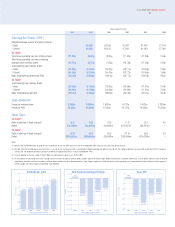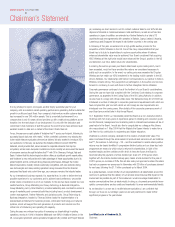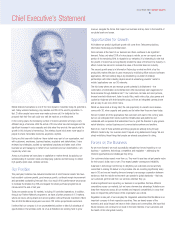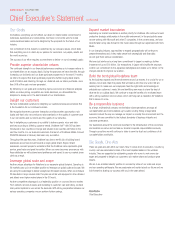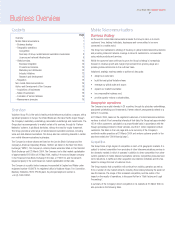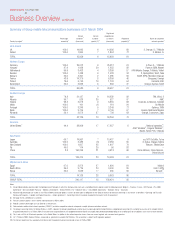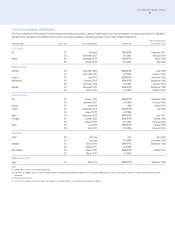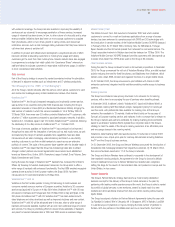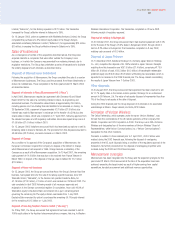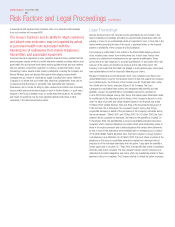Vodafone 2004 Annual Report Download - page 15
Download and view the complete annual report
Please find page 15 of the 2004 Vodafone annual report below. You can navigate through the pages in the report by either clicking on the pages listed below, or by using the keyword search tool below to find specific information within the annual report.
industry-specific law and regulation covering telecommunications services and general
competition (anti-trust) law applicable to all activities. Some regulation implements
commitments made by Governments under the Basic Telecommunications Accord of
the World Trade Organisation to facilitate market entry and establish regulatory
frameworks. The following section describes the regulatory framework and the key
regulatory developments in the European Union (“EU”) and selected countries in which
the Group has significant interests. Many of the regulatory developments reported in
the following section involve on-going proceedings or consideration of potential
regulation which have not reached a conclusion. Accordingly, the Group is unable to
attach a specific level of financial risk to the Group’s performance from such matters.
European Union
The Member States of the European Union (“Member States”) were expected to
implement the new EU Regulatory Framework for the communications sector (“the
new EU Framework”), which was adopted in 2002, into national law by 24 July 2003.
Denmark, Finland, Ireland, Norway, Sweden, and the UK had completed
implementation by that date. Austria, Italy, Portugal, and Spain have since completed
implementation. In April 2004, the European Commission (“the Commission”) issued
infringement proceedings against those Member States that had failed to implement
the new EU Framework, being Belgium, France, Germany, Greece, Luxembourg and
the Netherlands.
Those countries which joined the EU on 1 May 2004, including Hungary, Poland and
Malta, were required to implement the new EU Framework before accession. Hungary
implemented the new EU Framework in January 2004. However, Malta and Poland
have not yet implemented the new EU Framework.
The new EU Framework consists of four principal Directives outlining matters such as
the objectives to be pursued by national regulatory authorities (“NRAs”), the way in
which telecommunications operators are to be licensed, measures to be taken to
protect consumers and ensure universal provision of certain telecommunications
services and the terms and basis upon which operators interconnect and provide
access to each other.
The new EU Framework introduces a number of important changes to the previous
framework. It is intended to align the techniques for defining where sector specific
regulation may be applied and the threshold for when such regulation can be applied
with those already employed in EU competition law. It is also intended to ensure
greater consistency of approach amongst NRAs within the Member States. All NRAs
are required to take utmost account of the list of markets which are specified by the
Commission in a Recommendation when deciding which markets to investigate. The
first such Recommendation was published by the Commission in February 2003 and
includes the market for ‘voice call termination on individual mobile networks’, the
‘wholesale national market for international roaming’ and the market for ‘access and
call origination’ on mobile networks (“the relevant markets”). NRAs may, with the
Commission’s consent, also propose markets not included in the Recommendation.
The Commission will periodically review the Recommendation.
Regulation, under the new EU Framework, can only be applied to undertakings with
significant market power (“SMP”) (either individually or collectively) in the relevant
markets so identified, subject to the Commission’s consent. SMP under the new EU
Framework accords with the concept of “dominance”under existing EU competition
law. This generally implies a market share of at least 40%, although other factors may
also be taken into consideration. The SMP threshold under the previous framework
required only a 25% share of the relevant market. The Commission published SMP
Guidelines in July 2002. These guidelines set out principles for use by NRAs in the
analysis of markets and effective competition to determine if undertakings have SMP
in a relevant market under the new EU Framework.
In April 2004, the European Regulators Group (“ERG”), comprising Member State
NRAs and the Commission, issued a common position on the application of remedies
Annual Report 2004 Vodafone Group Plc
13
Strategy department, research into technology that will typically start to be used in
Vodafone’s business in three or more years time, leadership for the Group’s work in
international standards, and tactical development work largely on behalf of Group
Marketing and Group Technology and Business Integration. Governance of Group R&D
is provided by the Group R&D Steering Committee. The Group Strategy Director chairs
this committee which, along with the Group R&D Director, consists of the chief
technology officers from eight of the operating companies, together with the head of
products and services in Group Marketing and the heads of three functions within
Group Technology and Business Integration.
Group R&D focuses on applied research that is positioned between the basic research
undertaken by universities and commercial product development. Since the Group is
primarily a user of technology, the emphasis of the Group R&D work programme is on
providing technology analysis and vision that can contribute directly to business
decisions, enabling new applications of mobile telecommunications, using new
technology for new services, and research for improving operational efficiency and
quality of the Group’s networks. The work of the function is organised into five main
streams: applied research, strategic technology analysis, standards and industry fora,
intellectual property development and publicity and communications. The applied
research and strategic technology analysis functions are concerned with expanding
business boundaries, disruptive technologies, customer behaviour, service enablers,
terminals and smart cards, radio technologies, network architectures, performance
and optimisation, and security and computing technologies.
The work of Group R&D is delivered through four main programmes concerned with
radio, IP networks, service enablement and business support. In addition, Group R&D
provides leadership for funding research into health and safety aspects of mobile
telecommunications, technical support for the Group’s spectrum strategy and technical
support for the protection of intellectual property, including the Vodafone patent
portfolio.
Much of the work of Group R&D is done in collaboration with others, both within the
Group and external to it. For example, Group R&D provides leadership for the Group’s
involvement with international standards, although many delegates and contributions
are drawn from the Group’s operating companies. Group R&D provides the means to
protect the Group’s intellectual property, many of the innovations that are protected
coming from across the operations, and Group functions’ infrastructure and handset
suppliers work with Group R&D on many of its projects – from providing equipment for
trials, through co-authoring research reports, to being a partner in some of the
research and development programmes. At the more academic end of the spectrum of
applied research, Group R&D has developed relationships with a number of
universities. These include sponsoring research students, collaboration in European
research activities, funding specialised research activities and fostering working
relationships with academic chairs and readerships funded through the Vodafone
Foundation.
The research and development programme provides the Group with long-term
technical policy, strategy and leadership, as well as providing technical underpinning
for the Group’s public policies and government relations, and is shared with all
subsidiaries of the Company and Group functions. They are able to influence the
programme through working relationships that are designed to allow delivery of the
results of the programme directly into the business units where they are needed.
The Group spent £171 million in the 2004 financial year on research and
development, compared with £164 million in 2003 and £110 million in 2002. This
expenditure was incurred principally on developing new products and services, billing
systems and on network development.
Regulation
The Group’s operating companies are generally subject to regulation governing the
operation of their business activities. Such regulation generally takes the form of


